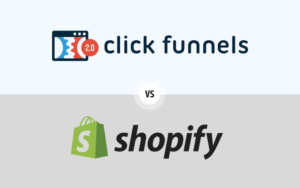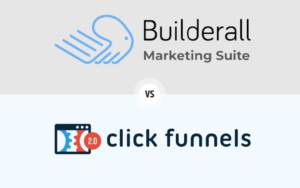We use affiliate links and may receive a small commission at no cost to you.
Key Takeaways: ActiveCampaign vs tinyEmail
I’ve tried both ActiveCampaign and TinyEmail, and I really like them for different reasons.
ActiveCampaign offers a comprehensive suite of tools for email marketing, marketing automation, and CRM. It is a top choice for businesses looking for a comprehensive marketing solution.
On the other hand, if your focus is on eCommerce and you’re looking for specialized tools to boost online sales, tinyEmail would be the better choice. It stands out for its user-friendly email creation tools and large library of designer templates.
Both are solid options. Your choice between ActiveCampaign vs tinyEmail should align with your specific business needs. Please read on for more information.
Table of Contents
ActiveCampaign vs tinyEmail Features
Comparing the features of ActiveCampaign vs tinyEmail provides a clear picture of what each platform offers:
ActiveCampaign Key Features:
- Marketing Automation: Known for its powerful automation capabilities, ActiveCampaign allows you to create automated workflows responsive to subscriber behavior, with features like split testing, dynamic content, and personalization.
- Email Builder and Segmentation: It offers a user-friendly drag-and-drop interface for custom email creation and robust segmentation features. These features help users run focused campaigns.
- Landing Pages and Online Marketing: ActiveCampaign enables the creation of custom landing pages, social media account management, and targeted ad campaigns across various channels.
- Third-Party Integrations and API: ActiveCampaign connects with a wide array of applications and services, offering extensive API functionalities for custom integrations.
- Customer Relationship Management (CRM): The CRM feature manages contacts, tracks deals, and automates sales processes, integrating seamlessly with marketing campaigns for personalized messaging.
TinyEmail Key Features:
- Email Editor: TinyEmail’s intuitive drag-and-drop editor is user-friendly. It allows you to create professional emails. You can customize them with options like images, videos, and social media links.
- Contact Management: It allows users to easily import and export contacts. Users can also group people based on interests or actions. Additionally, the platform enables users to create automatic messages.
- Dynamic Content: TinyEmail excels in creating dynamic content tailored to individual subscriber data, enhancing open rates and engagement.
- Analytical Tools provide live data to monitor email campaign performance. This includes open rates, click rates, and A/B testing for campaign optimization.
- Automated Campaigns: TinyEmail automates email campaigns based on subscriber actions, ensuring timely and relevant information delivery to keep subscribers engaged.
In summary, comparing ActiveCampaign vs tinyEmail, ActiveCampaign offers a more comprehensive suite of features, including CRM and advanced integrations, suited for businesses seeking an all-in-one marketing solution. TinyEmail, with its focus on ease of use and AI-driven personalization, is particularly tailored for eCommerce businesses looking for streamlined, effective email marketing.

Personal Experience with ActiveCampaign vs tinyEmail.
As a user who has had the opportunity to compare ActiveCampaign vs tinyEmail, I’ve gained valuable insights into the strengths and unique offerings of each platform. My review here aims to provide an unbiased perspective, highlighting the positive aspects of both tools while considering their differences.
ActiveCampaign Experience:
Using ActiveCampaign revolutionized my email marketing and automation approach. Its advanced automation features enabled sophisticated, customizable workflows, greatly aiding in lead nurturing and personalized customer journeys.
The CRM integration streamlined tracking customer interactions and sales processes, blending marketing and sales seamlessly. While the interface took some getting used to, it became intuitive.
Integrating ActiveCampaign with other tools saved time and streamlined my workflow. However, maximizing its potential does require some marketing know-how, which might be overwhelming for beginners or small businesses with simpler needs.
Related: Visit my post on tinyEmail vs Moosend
TinyEmail Experience:
Switching to tinyEmail, I appreciated its simplicity and user-friendliness, ideal for newcomers to email marketing or those who prefer an uncomplicated approach. Creating attractive emails was quick and easy with the drag-and-drop editor.
TinyEmail’s AI-driven personalization features were great, enhancing engagement in my campaigns without the complexity often associated with such functionality.
Its automation features, though less extensive than ActiveCampaign, efficiently handled basic requirements like welcome emails and abandoned cart reminders.
A major benefit of tinyEmail was its analytical tools. The real-time reports offered instant insights into campaign performance, aiding in prompt adjustments for improved results.
When comparing ActiveCampaign vs tinyEmail, they each have their unique strengths and cater to different needs. ActiveCampaign is a powerhouse suitable for those who need comprehensive, detailed marketing and CRM tools. In contrast, tinyEmail shines in its simplicity and user-friendly interface, ideal for e-commerce businesses and those starting their email marketing journey. Both platforms offer robust capabilities to enhance email marketing strategies.

ActiveCampaign vs tinyEmail Pricing Comparison
Comparing the pricing structures of ActiveCampaign vs tinyEmail offers insights into the flexibility and scalability each platform provides for different business needs.
ActiveCampaign Pricing: ActiveCampaign’s pricing is structured into four main tiers, each offering progressively more features:
- Lite Plan: Aimed at solopreneurs, this plan starts at a price that varies based on the number of contacts and billing cycle (monthly or annually). Features include email marketing, marketing automation, 24/7 chat and email support, inline forms, site and event tracking, automation and campaign reports, API, and webhooks.
- Plus Plan: Designed for small teams, this plan includes everything in the Lite plan plus additional features like landing pages, Facebook custom audiences and lead ads, lead scoring, pop-up and modal forms, conditional content, and integrations with WooCommerce, Shopify, and BigCommerce.
- Professional Plan: Targeting teams that want to optimize their marketing efforts, this plan offers everything in the Plus plan plus predictive sending AI, split automations, Salesforce and Microsoft Dynamics 365 integrations, site messages, attribution reporting, conversions, and goals.
- Enterprise Plan: Suited for larger organizations looking to personalize marketing at scale, this plan includes all features of the Professional plan plus custom reporting, custom objects, single sign-on, HIPAA support, uptime SLA, custom mailserver domain, unlimited email testing, and more.
The specific pricing for each plan is customized based on the number of marketing contacts and additional features required.
TinyEmail Pricing: TinyEmail’s pricing structure is based on the volume of emails sent per month, offering a range of plans to cater to different business sizes:
- Free Plan: After a full-featured 7-day trial, tinyEmail offers a free plan for up to 15k emails per month, including 500 subscribers, forms and popups, automation emails, limited AI subject line assistance, and other features.
- Standard Plan: Priced at $15 per month, this plan includes everything in the Free plan plus unlimited subscribers, premium and AMP templates, custom modules, more AI subject line assistance, and a custom domain.
- Pro Plan: For $65 monthly, this plan extends the Standard plan features with unlimited prebuilt and custom segments, unlimited AI subject line assistance, a dedicated IP, and priority support.
- Shopify Pro: Exclusively free for Shopify users, this plan includes everything in the Standard plan with additional perks tailored for Shopify integrations.
- Enterprise Plan: Aimed at large companies, this custom-priced plan offers everything in the Pro plan plus capabilities for sending billions of emails, high-volume pricing, enhanced delivery, premium dedicated IP, upcoming API access, dedicated instance, account managers, and enterprise-grade security.
The pricing for ActiveCampaign vs tinyEmail is adjustable based on the number of emails sent per month, allowing businesses to scale their usage as needed.

ActiveCampaign vs tinyEmail Pro’s & Con’s
Evaluating the pros and cons of ActiveCampaign vs tinyEmail can provide a clearer understanding of which platform may be best suited to your specific needs.
ActiveCampaign Pros:
- Comprehensive Features: Offers a wide range of tools including email marketing, automation, CRM, and advanced segmentation.
- Marketing Automation: Powerful automation capabilities for sophisticated and targeted marketing strategies.
- Extensive Integrations: Over 870 integrations with various third-party applications.
- CRM Integration: Seamlessly integrates marketing efforts with sales processes.
- Customizable Campaigns: Advanced options for personalizing and optimizing email campaigns.
ActiveCampaign Cons:
- Complexity: The extensive range of features can be overwhelming for beginners or small businesses with simple needs.
- Cost: While offering a variety of plans, pricing can be higher compared to some competitors, especially as you scale up.
- Learning Curve: The robust functionalities necessitate a learning period to fully utilize the platform’s capabilities.
TinyEmail Pros:
- User-Friendly Interface: Designed for ease of use, especially beneficial for those new to email marketing.
- AI-Driven Personalization: Utilizes AI for content personalization, enhancing engagement and open rates.
- E-commerce Focus: Tailored for e-commerce businesses with features to specifically support online stores.
- Effective Automation: Simplified yet effective automation for creating email sequences.
- Analytical Tools: Provides real-time insights with a robust reporting system.
TinyEmail Cons:
- Limited Advanced Features: May not offer the same depth of advanced features as more comprehensive platforms like ActiveCampaign.
- E-commerce Specificity: While beneficial for online stores, it may not be as versatile for businesses outside e-commerce.
- Lesser Integration Options: Compared to ActiveCampaign, tinyEmail has fewer integrations with third-party applications.

ActiveCampaign vs tinyEmail Conclusion
In conclusion, ActiveCampaign and tinyEmail are both robust email marketing platforms, each with its unique strengths and offerings tailored to different business needs and preferences.
ActiveCampaign distinguishes itself with a comprehensive array of features, including advanced marketing automation, CRM integration, extensive third-party integrations, and powerful analytical tools. It’s an excellent choice for businesses that require a full-suite marketing and sales solution and are ready to invest in a more complex system to fully leverage the depth of functionalities offered. However, its complexity and cost might be challenging for smaller businesses or those who need simpler solutions.
On the other hand, tinyEmail excels with its user-friendly interface, AI-driven personalization, and specific focus on e-commerce. It is ideal for businesses, particularly in the e-commerce sector, looking for an easy-to-use, efficient email marketing tool with the capability to scale as per email volume. While it provides effective automation and real-time analytics, it may lack the advanced features and extensive integrations that a platform like ActiveCampaign offers.
Both platforms provide robust capabilities to enhance your email marketing efforts, each catering to different segments of the market with their specialized features. So the question is ActiveCampaign vs tinyEmail?
Related: See my blog post about Moosend vs tinyEmail.

![You are currently viewing ActiveCampaign vs tinyEmail: Easy Email Marketing in [2024]](https://itsyourlifejourney.com/wp-content/uploads/2023/12/Yellow-Modern-Football-Match-Highlights-Youtube-Thumbnail2.png)



Pingback: Moosend Vs TinyEmail: The Best Tool For You - It's Your Life Journey